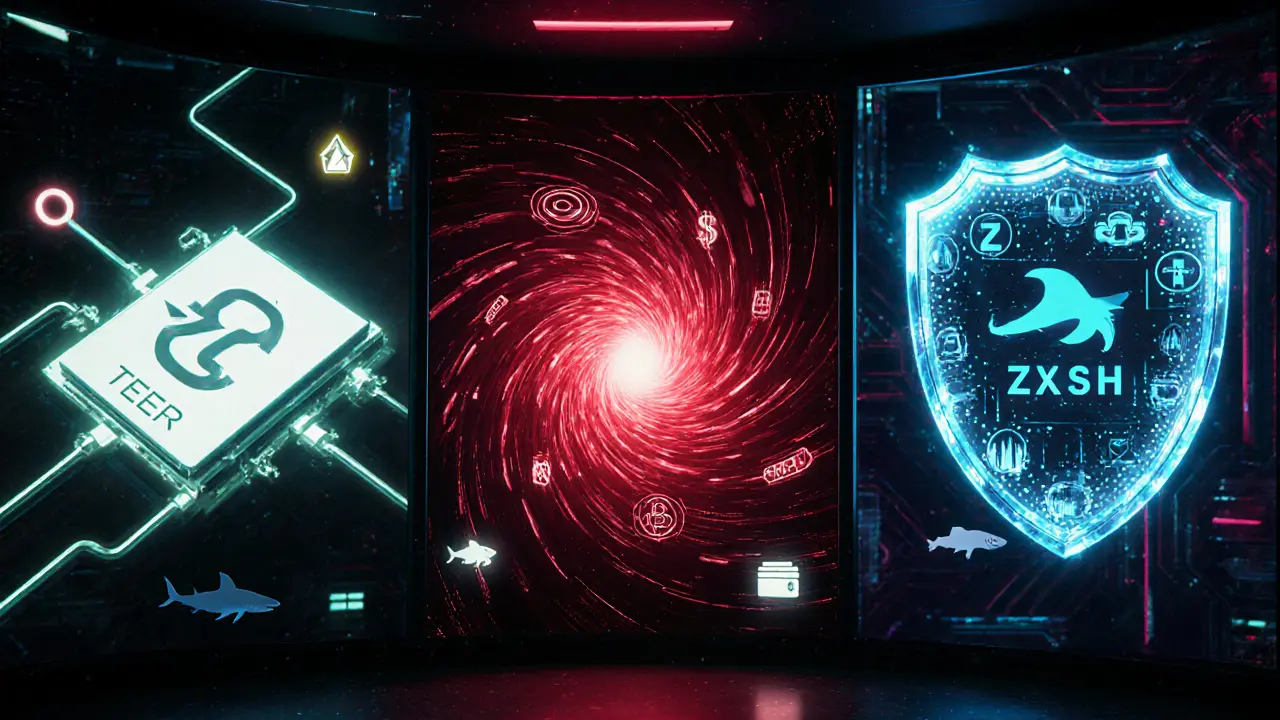TEER Token Price & Market Analysis
Current TEER Token Status
As of October 3, 2025. Price has fluctuated significantly since its all-time high of $5.09 in January 2022.
Tokenomics Overview
- Total Supply: 10 million TEER
- Circulating Supply: ~3.97 million (39.7%)
- Fully Diluted Valuation: ~$975,000
- 24h Volume: $30,000 - $36,000
TEER is a micro-cap token with limited holder distribution and significant price volatility.
Privacy Coin Comparison
| Feature | TEER (Integritee) | Monero (XMR) | Zcash (ZEC) |
|---|---|---|---|
| Core privacy tech | TEE hardware + Polkadot security | Ring signatures & stealth addresses | zk-SNARKs (optional shielded) |
| Regulatory focus | GDPR-compliant proofs | None (privacy-by-default) | Selective disclosure |
| Market cap (Oct 2025) | ≈ $0.4M | ≈ $1.2B | ≈ $0.8B |
| Primary use case | Enterprise data processing | Anonymous payments | Private transactions & DeFi |
| Consensus | Polkadot parachain + staking | Proof-of-Work (RandomX) | Proof-of-Work (Equihash) |
TEER's unique combination of hardware-rooted privacy and regulatory-grade compliance sets it apart from purely anonymous privacy coins.
Risk Assessment
- Micro-cap volatility: With a market cap under $400K, price swings of 20%+ in a single day are common.
- Holder concentration: Only about 25 wallets hold the majority of TEER, meaning large trades can move the market.
- Technical complexity: Deploying TEE-based dApps requires specialized hardware, which may limit developer adoption.
- Regulatory uncertainty: Future privacy laws could introduce new compliance layers.
While TEER presents potential for growth in enterprise privacy solutions, investors should carefully consider these risks before investing.
Quick Overview
- Integritee Network is a privacy‑first blockchain that mixes Polkadot security, side‑chain scalability and Trusted Execution Environments (TEE).
- Its native token TEER supplies staking, governance and fee payments.
- As of 3Oct2025 the token trades around $0.097 with a market cap under $400K.
- TEER is listed on Gate.io, Kraken and UniswapV4 (Ethereum).
- Key risks: micro‑cap volatility, limited holder distribution and heavy reliance on specialized hardware.
What Is Integritee Network?
Integritee Network is a blockchain‑based privacy infrastructure platform that enables firms and decentralized applications (dApps) to process user data in a privacy‑preserving way while staying compliant with regulations such as GDPR. By combining the trust mechanisms of Polkadot, the scalability of second‑layer sidechains and the confidentiality of Trusted Execution Environment (TEE) hardware, the network aims to provide verifiable proof that privacy requirements have been respected during data processing.
In plain terms, think of Integritee as a secure vault built on a public ledger. Data never leaves the vault in clear form, yet anyone can audit that the vault followed the rules. This solves a major hurdle for enterprises that want the transparency of blockchain but cannot expose sensitive customer information.
Integritee Network positions itself at the crossroads of blockchain, data privacy and regulatory compliance - a niche that is becoming more valuable as governments tighten data‑protection laws worldwide.
How the Technology Works
The core of the system is Trusted Execution Environment (TEE) hardware. TEEs create isolated “enclaves” where code runs shielded from the operating system, hypervisor and even the physical owner of the machine. Sensitive computations - for example, a credit‑score calculation or a medical‑data analysis - happen inside these enclaves, so the raw data never appears on the public chain.
Integritee plugs TEEs into the Polkadot ecosystem, inheriting its shared security model and cross‑chain capabilities. Polkadot’s relay chain validates the correctness of sidechain blocks, while sidechains (called “enclave chains”) handle the heavy privacy‑preserving workloads. This hybrid approach delivers two big benefits:
- Scalability: Most privacy‑intensive operations stay off the main relay chain, preventing bottlenecks.
- Interoperability: Assets and data can flow to other parachains, opening doors for multi‑chain privacy solutions.
From a compliance standpoint, Integritee embeds verifiable proofs that GDPR‑related steps - such as user consent, data minimization and the right to be forgotten - have been performed. Auditors can check these proofs without ever seeing the underlying personal data.
Tokenomics - The TEER Token
The network’s native utility token is TEER. TEER serves three main purposes:
- Staking: Validators lock TEER to secure enclave chains and earn rewards.
- Governance: Token holders vote on protocol upgrades, fee structures and privacy‑policy parameters.
- Transaction fees: dApps pay TEER to execute privacy‑preserving operations inside TEEs.
Key figures (as of 3Oct2025):
- Total supply: 10million TEER (capped).
- Circulating supply: ~3.97million (≈39.7%).
- Market cap: ~US$387K.
- Fully diluted valuation (FDV): ~US$975K.
- 24‑hour volume: $30K-$36K.
The token’s price has swung dramatically - from an all‑time high of $5.09 in January2022 down to a recent low of $0.09144 in September2025, with a modest recovery to about $0.097 today. Such volatility is typical for micro‑cap privacy projects.

Where to Trade TEER and How to Buy
Despite its small market cap, TEER is listed on three reputable venues:
- Gate.io - offers TEER/USDT and TEER/BTC pairs.
- Kraken - provides a fiat‑on‑ramp via USDT.
- Uniswap V4 on the Ethereum network - ideal for users comfortable with DeFi wallets.
Typical steps to acquire TEER:
- Set up a non‑custodial wallet that supports Ethereum ERC‑20 tokens (e.g., MetaMask, Trust Wallet).
- Deposit ETH or USDT into the wallet.
- Connect the wallet to Uniswap V4 and swap your chosen asset for TEER using the contract address
0x7699…ea622b. - If you prefer centralized exchanges, create an account on Gate.io or Kraken, complete KYC, and place a market order for the TEER/USDT pair.
Remember to move tokens off the exchange into your personal wallet if you plan to stake or participate in governance.
Use Cases and Compliance Benefits
Integritee’s privacy guarantees open up several real‑world scenarios:
- Financial services: Confidential loan underwriting or AML checks without exposing raw customer data.
- Healthcare: Secure sharing of patient statistics for research while preserving HIPAA‑level privacy.
- Supply‑chain tracking: Verifiable provenance data that stays hidden from competitors.
Because the platform embeds GDPR‑compatible proofs, European companies can adopt the technology without risking hefty fines. The same approach can be adapted for other regulations such as CCPA or Brazil’s LGPD.
Risks, Challenges and Outlook
Investors should weigh several factors before diving into TEER:
- Micro‑cap volatility: With a market cap under $400K, price swings of 20%+ in a single day are common.
- Holder concentration: Only about 25wallets hold the majority of TEER, meaning large trades can move the market.
- Technical complexity: Deploying TEE‑based dApps requires specialized hardware, which may limit developer adoption.
- Regulatory uncertainty: While GDPR compliance is a selling point, future privacy laws could introduce new compliance layers.
On the upside, the growing demand for privacy‑preserving solutions could lift Integritee’s relevance. Partnerships with enterprise players or integration into larger Polkadot parachains would provide the network effect needed for broader adoption.
How TEER Stacks Up Against Other Privacy Coins
| Feature | TEER (Integritee) | Monero (XMR) | Zcash (ZEC) |
|---|---|---|---|
| Core privacy tech | TEE hardware + Polkadot security | Ring signatures & stealth addresses | zk‑SNARKs (optional shielded) |
| Regulatory focus | GDPR‑compliant proofs | None (privacy‑by‑default) | Selective disclosure |
| Market cap (Oct2025) | ≈$0.4M | ≈$1.2B | ≈$0.8B |
| Primary use case | Enterprise data processing | Anonymous payments | Private transactions & DeFi |
| Consensus | Polkadot parachain + staking | Proof‑of‑Work (RandomX) | Proof‑of‑Work (Equihash) |
The table shows that TEER’s differentiator is its hardware‑rooted privacy model combined with regulatory‑grade compliance, whereas Monero and Zcash aim for pure anonymity without explicit legal alignment.
Next Steps for Interested Readers
If you’re a developer, start by exploring Integritee’s SDK on GitHub - the documentation walks you through creating a simple enclave‑based smart contract. For investors, monitor the TEER/USDT volume on Gate.io and Kraken; a sudden spike often signals a larger stakeholder moving tokens. Finally, keep an eye on Polkadot’s parachain auctions - a successful slot win for Integritee could dramatically improve its exposure and liquidity.

Frequently Asked Questions
What problem does Integritee Network solve?
It lets companies run data‑intensive computations on a public blockchain while keeping the raw data secret and providing verifiable compliance with privacy laws such as GDPR.
How does TEER differ from other privacy coins?
TEER relies on Trusted Execution Environments and Polkadot’s parachain model, focusing on enterprise use cases and regulatory proof, whereas most privacy coins use cryptographic tricks (ring signatures, zk‑SNARKs) for anonymous payments.
Where can I buy TEER?
TEER is available on Gate.io, Kraken and the Uniswap V4 DEX on the Ethereum network. After buying, move the tokens to a personal wallet for staking or governance.
Is TEER a good long‑term investment?
Because TEER is a micro‑cap token, it carries high risk and price swings. Its long‑term potential depends on real‑world adoption of privacy‑preserving data processing and successful integration into Polkadot’s parachain ecosystem.
Can I stake TEER to earn rewards?
Yes. Validators lock TEER as collateral on the Polkadot parachain that hosts Integritee. Stakers earn a share of transaction fees and block‑production rewards.





Comments
20 Comments
Natasha Nelson
I just bought my first TEER tokens today... I mean, it's tiny, but it feels like the right time to get in. Seriously, privacy is the future, and this tech? It's not magic-it's real.
Just don't panic if it dips tomorrow. I'm holding.
Sarah Hannay
While the technical architecture is undeniably sophisticated, one must not overlook the inherent risks associated with micro-capitalization assets. The concentration of supply among twenty-five entities introduces systemic fragility that is incompatible with sustainable long-term investment paradigms.
Richard Williams
This is actually one of the most promising privacy projects I've seen in a while. TEEs on Polkadot? That’s a combo that could actually make enterprises adopt blockchain without sweating compliance.
People are sleeping on this. Don’t be one of them.
Prabhleen Bhatti
India is waking up to privacy tech, and honestly, Integritee’s GDPR-aligned model is perfect for our upcoming DPDP Act! TEEs + Polkadot = game changer. We’ve got so many fintech startups here that need this.
Just hope the hardware isn’t too expensive for local devs to deploy... we’re not all Silicon Valley startups.
Elizabeth Mitchell
Interesting. I don’t know much about blockchains, but the idea of a vault on a public ledger kinda makes sense. Like, you can see the vault is locked, but you can’t see what’s inside. That’s cool.
Chris Houser
I’ve seen this project before. The TEE angle is smart-enterprise adoption is the real win here, not just crypto speculation.
But let’s be real: if you don’t have access to Intel SGX hardware or AMD SEV, you’re basically out. That’s a huge barrier.
William Burns
One must question the intellectual rigor of promoting a token with a market cap under $400K as a 'privacy blockchain.' This is not innovation-it is speculative noise dressed in academic jargon. The reliance on proprietary TEE hardware renders it fundamentally centralized.
Ashley Cecil
The article contains multiple grammatical inconsistencies. For instance, 'TEER is listed on Gate.io, Kraken and UniswapV4'-the Oxford comma is omitted. Furthermore, 'uniswapv4' should be capitalized as 'Uniswap V4.' Such sloppiness undermines credibility.
John E Owren
I’ve been watching TEER since it crashed from $5. I didn’t buy then. I’m not buying now. But I respect the engineering. If this thing ever gets real enterprise traction, it could be the quiet giant of privacy infra. Just… not today.
Joseph Eckelkamp
Ah yes, the classic 'privacy blockchain' that requires you to trust Intel, AMD, and a handful of validators to not backdoor your data.
Meanwhile, Monero runs on your grandma’s laptop and doesn’t need a $5,000 server.
But sure, let’s call this 'compliance.' I’ll believe it when I see it on a public audit log.
Jennifer Rosada
This is exactly why crypto is a disaster. People are treating a $400K market cap token like it’s Bitcoin.
Do you know how many people have been ruined by micro-caps like this? You think you're 'early'-you're just the next sucker who buys the dip before it goes to zero.
adam pop
TEE hardware is a backdoor. The NSA designed it. They control the firmware. They can read your data anytime. This isn’t privacy-it’s surveillance with a blockchain sticker on it.
They want you to think you’re safe while they watch everything. Wake up.
Dimitri Breiner
Honestly, this is the most realistic privacy project I’ve seen in years. Most privacy coins are just obfuscation. This is actual secure computation.
And yeah, the market cap is tiny-but that’s why you get in now. The real money’s in infrastructure, not just anonymous payments.
LeAnn Dolly-Powell
I’m so excited for this!! 🌟 Privacy + blockchain + real-world use cases? Yes please!!
Just bought some TEER and staked it already!! Can’t wait to see what happens next!! 💪✨
Anastasia Alamanou
The real value here isn’t the token-it’s the framework. If Integritee can onboard even a few healthcare providers in the EU, this becomes mission-critical infrastructure.
Most people are focused on price, but the tech could redefine how data is handled globally.
Rohit Sreenath
You think this is innovation? You’re just chasing the hype. Real wealth is in land, gold, and knowledge. Crypto is a distraction for the gullible.
And TEE? That’s just a fancy word for trusting corporations again.
Sam Kessler
Polkadot is a centralized mess disguised as decentralization. And TEEs? That’s not trustless-it’s trust-minimized, which is just a euphemism for 'we’re relying on hardware companies we can’t audit.'
This isn’t blockchain. It’s corporate surveillance with a whitepaper.
Steve Roberts
Everyone says this is 'the future,' but the truth? No enterprise is going to run their data on a blockchain that’s controlled by a token with less liquidity than my coffee fund.
This is vaporware dressed up like a startup pitch.
John Dixon
Oh wow, a $400K market cap 'privacy blockchain'... I guess that’s why we can’t have nice things.
Next they’ll be selling 'GDPR-compliant' NFTs for your cat’s medical records.
And yes, I know the contract address. No, I’m not buying.
Brody Dixon
I read through this carefully. The tech is solid. The risks are real.
I’m not investing, but I’m keeping it on my watchlist. If they get a parachain slot and start seeing real dApp usage, I’ll reconsider. For now? Just observing.
Write a comment